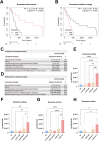Serum and exosome WNT5A levels as biomarkers in non-small cell lung cancer
- PMID: 40223089
- PMCID: PMC11995597
- DOI: 10.1186/s12931-025-03216-7
Serum and exosome WNT5A levels as biomarkers in non-small cell lung cancer
Abstract
Background: Despite significant advances in the treatment of lung cancer (LC), there are no reliable biomarkers to effectively predict therapy response and overall survival (O/S) in non-small cell lung cancer (NSCLC) subtypes. While targeted therapies have improved survival rates in lung adenocarcinoma (LUAD), effective treatment options for lung squamous cell carcinoma (LUSC) are still limited. Recent evidence indicates that exosome-bound WNT5A may significantly contribute to disease progression. Our study assessed the WNT5A protein as a potential biomarker for diagnosing patients and predicting prognosis to assist in therapy selection.
Methods: Primary tumor tissue and serum samples were collected from a cohort of 60 patients with histologically confirmed NSCLC before therapy. Healthy serum donors served as controls. Exosomes were isolated, then exosome number and size were measured, and WNT5A protein levels were identified in tissue and in vesicle-free, vesicle-bound fractions of the serum by ELISA.
Results: Extensive statistical analysis (ROC, AUC, Cox, etc.) revealed that elevated WNT5A levels on the serum-exosome surface correlated with distant metastasis, advanced disease stage, and lymph node involvement in LUSC but not in LUAD patients. Moreover, a high WNT5A exosome surface expression was associated with a poor response to therapy and shorter O/S in LUSC patients. Additionally, serum-exosome surface + cargo WNT5A content distinguished LUAD and LUSC subtypes.
Conclusions: WNT5A, particularly its serum exosome-bound form, may serve as a valuable biomarker after further validation for differentiating NSCLC subtypes and predicting disease progression. Importantly, the information can become available from a simple serum sample at the time of diagnosis.
Keywords: Exosome; Lung adenocarcinoma; Lung squamous cell carcinoma; Non-small cell lung cancer; WNT5A.
© 2025. The Author(s).
Conflict of interest statement
Declarations. Ethics approval and consent to participate: This study was carried out in accordance with the principles of the Declaration of Helsinki. Approval was granted by the Ethics Committee of the University of Pecs (Date2016/No6444). Written informed consent was obtained from all individual participants in the study. Consent for publication: N/A. Competing interests: The authors declare no competing interests. Clinical trial number: N/A.
Figures






Similar articles
-
Identifying diagnostic markers and establishing prognostic model for lung cancer based on lung cancer-derived exosomal genes.Cancer Biomark. 2025 Feb;42(2):18758592251317400. doi: 10.1177/18758592251317400. Epub 2025 Apr 3. Cancer Biomark. 2025. PMID: 40179422
-
Exploration of Serum Exosomal LncRNA TBILA and AGAP2-AS1 as Promising Biomarkers for Diagnosis of Non-Small Cell Lung Cancer.Int J Biol Sci. 2020 Jan 1;16(3):471-482. doi: 10.7150/ijbs.39123. eCollection 2020. Int J Biol Sci. 2020. PMID: 32015683 Free PMC article.
-
[Identification of differentially expressed genes between lung adenocarcinoma and squamous cell carcinoma using transcriber signature analysis].Nan Fang Yi Ke Da Xue Xue Bao. 2019 Jun 30;39(6):641-649. doi: 10.12122/j.issn.1673-4254.2019.06.03. Nan Fang Yi Ke Da Xue Xue Bao. 2019. PMID: 31270041 Free PMC article. Chinese.
-
Tumor-derived exosomal lncRNA GAS5 as a biomarker for early-stage non-small-cell lung cancer diagnosis.J Cell Physiol. 2019 Nov;234(11):20721-20727. doi: 10.1002/jcp.28678. Epub 2019 Apr 29. J Cell Physiol. 2019. PMID: 31032916
-
The Effect of GLUT1 on the Survival Rate and Immune Cell Infiltration of Lung Adenocarcinoma and Squamous Cell Carcinoma: A Meta and Bioinformatics Analysis.Anticancer Agents Med Chem. 2022;22(2):223-238. doi: 10.2174/1871520621666210708115406. Anticancer Agents Med Chem. 2022. PMID: 34238200 Review.
Cited by
-
Identification and verification of immune and oxidative stress-related diagnostic indicators for malignant lung nodules through WGCNA and machine learning.Sci Rep. 2025 Jul 1;15(1):22449. doi: 10.1038/s41598-025-04639-4. Sci Rep. 2025. PMID: 40594252 Free PMC article.
References
-
- Perez-Moreno P, Brambilla E, Thomas R, Soria JC. Squamous cell carcinoma of the lung: molecular subtypes and therapeutic opportunities. Clin Cancer Res. 2012;18:2443–51. - PubMed
-
- Mountzios G, Naidoo J, Wang C, Creelan BC, Trotier DC, Campbell TC, Peters S. Beyond chemoimmunotherapy in advanced Non-Small cell lung cancer: new frontiers, new challenges. Am Soc Clin Oncol Educ Book. 2024;44:e432526. - PubMed
-
- Bade BC, Dela Cruz CS. Lung cancer 2020: epidemiology, etiology, and prevention. Clin Chest Med. 2020;41:1–24. - PubMed
MeSH terms
Substances
LinkOut - more resources
Full Text Sources
Medical

